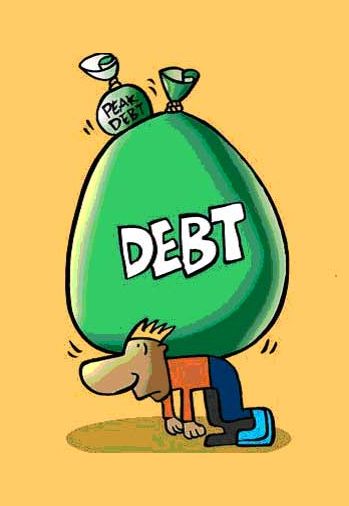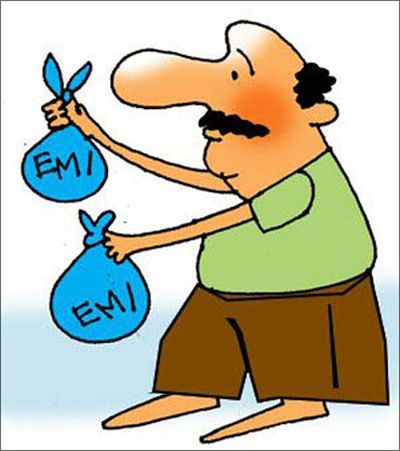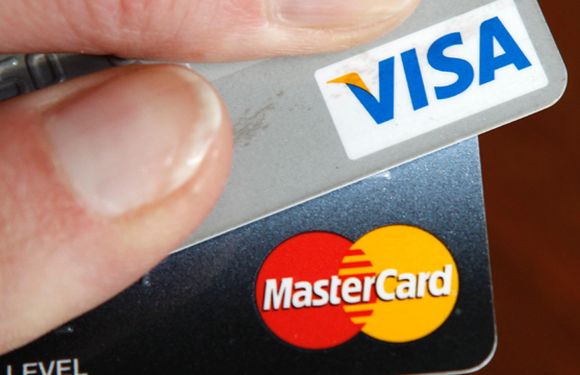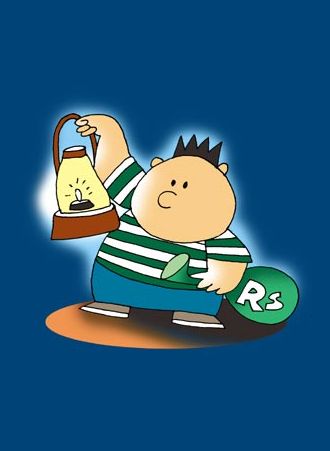Photographs: Uttam Ghosh/Rediff Neha Pandey Deoras in Bangalore
All it takes are a couple of credit card bills, a personal loan, an automobile loan and a home loan for your pecuniary position to slip into the financial equivalent of a black hole.
Ajay Kumar (name changed), who plans to approach a debt counsellor soon, finds himself in a similar position.
He has a housing loan of Rs 20 lakh, a car loan of Rs 500,000, two credit card bills (Rs 50,000 and Rs 35,000) and a personal loan of Rs 200,000 (for a medical emergency). Today, his liabilities stand at a massive Rs 25 lakh.
The rate at which he is paying these off (Rs 48,952 a month), it could take him 21 years and nine months (excluding the credit cards) to do so. His monthly take-home salary pay is Rs 75,000.
Ideally, equated monthly instalments (EMIs) shouldn't exceed 40-45 per cent of the take-home pay. For Kumar, it stands at 65 per cent.
Sanjay Agarwal, senior vice-president and group head (retail business & technology solutions) at Arcil, believes this norm is flexible.
...
Tips to regularise your debt
Photographs: Uttam Ghosh/Rediff
"If the income is Rs 30,000 a month in Mumbai, an EMI of Rs 10,000 (33 per cent of the salary) could be paid, as Rs 20,000 is needed to survive here. But for an income of Rs 100,000, the EMI could easily go up to 50 per cent.
The EMI-to-income ratio also depends on the city of residence and the number of family members," he says.
He recommends a cushion, post-EMI-payment, to ensure one saves up to six months of monthly expenses for a rainy day.
Unfortunately, most end up with a high EMI-to-income ratio, subsequently borrowing more to retire previous loans - a classic debt trap. According to Madan Mohan, chief counselor at Credit Vidya, one should borrow only if one genuinely needs to.
Many people borrow, especially through credit cards, because they are being offered by banks.
"If you have to borrow, know the best way to go about it. For instance, for house repairs either choose a top-up on a home loan or take a house-repair loan. But many take a personal loan, on which the charge is higher for a shorter term," he says. Withdrawing cash through credit cards is also a high-cost loan.
...
Tips to regularise your debt
Image: First get rid of credit card balances as you could end up paying 40-50 per cent interest a year.Photographs: Kevin Lamarque/Reuters
If your finances are haywire, refinance your home loan, either through the same lender or through a new one, depending on who offers a lower rate, says Adhil Shetty, chief executive of BankBazaar.com.
This would help cut costs. Here, the previous loan contract is terminated and a new one is made at the current rate, for a processing fee of 1-1.5 per cent of the loan amount.
When overleveraged, start cleaning up your act. This ensures the debt doesn't drain your funds and you can raise more.
Start with credit cards, the most expensive loan, as you could end up paying 40-50 per cent interest a year, says Agarwal.
Personal loans, which charge 15-30 per cent a year, come next. This is because these are unsecured loans - there is no collateral.
Car loans, though expensive, come with a cushion - the car can be sold for cash. Home loans, the largest in terms of the amount, offer tax benefits and, therefore, need not be retired in haste.
Interest repayment (up to Rs 150,000) towards a home loan and principal repayment (up to Rs 100,000) can be deducted from taxable income.
...
Tips to regularise your debt
Image: If you have gold, borrow against it to repay high interest loans.Photographs: Ajay Verma/Reuters
An additional deduction of Rs 100,000 is also applicable for this year only in interest repayment for a house bought in 2013-14, if the loan amount is below Rs 25 lakh.
How to repay
An easy way is to redeem investments to cut high-cost loans. If this isn't possible, opt for a loan on fixed deposits, which charge 0.5-1 per cent more than the deposit rate, says Mohan of Credit Vidya.
Gold loans from public sector banks are cheaper than those from private ones or non-banking financial companies. However, as Indians usually own jewellery, the value of gold goes down by 10-15 per cent.
If you don't have many assets, consolidate the loans by taking a larger personal loan and retiring high-cost ones. But this is advised only if the new loan comes at a low cost or an extended repayment term.
There are cheaper options such as taking a loan against property; most banks offer this. Here, the amount is much higher and this could allow you to retire high-cost loans at once.
This is how it works: If you own property worth Rs 45 lakh, a bank would be willing to lend you 40-60 per cent of the value. However, if you have an existing loan on the property, the valuation drops.
...
Tips to regularise your debt
Photographs: Uttam Ghosh/Rediff
So, if a property worth Rs 45 lakh was bought on loan and its present value is Rs 60 lakh, the bank would lend 40-50 per cent of the incremental value.
How lenders can help
Banks first try to understand the reason behind a default. If banks believe the problem is genuine and the borrower is serious about paying EMIs, they might bend. However, such decisions vary from case to case.
If the default is due to a temporary cash crunch, which might not last six months, banks could offer a repayment holiday for that period. Your EMI could also be lowered or the loan term lengthened, without raising the EMI.
It takes three defaults for banks to send a demand notice and declare a loan as non-performing. Then, too, borrowers are given two months to repay dues.
Banks allow you to repay and reclaim your property even after it has been seized. Habitual defaulters are not given such leeway. At best, the loan term is extended by six months for such customers.
"Here's where advisors are helpful. An independent advisor helps customers negotiate with banks for options such as a secured credit card, which is linked to a fixed deposit with the bank. This helps the defaulter rebuild a credit history," says Ranjit Punja, founder of credit advisory firm Credit Mantri.
...
Tips to regularise your debt
Case Study: Ajay Kumar's Revival Plan
Assets
Fixed deposits = Rs 40,000
Life insurance = Rs 500,000
Advice by SanjayAgarwal, a debt counsellor
Don't touch home and car loans, as interest rates are almost the same and well within repayment capacity. Here are the options:
Option 1: Survive on tight budget for another seven-eight months, after which the personal loan gets over, saving Rs 18,052.
Break FD and repayas much card dues as possible. For balance, request for as long a loan term as possible. This will mean EMI pain lasts for another 7-8 months.
Option 2: Geta loan on insurance for a longer tenure and clear card dues and personal loan fully, in that order. This depends on the insurer, policy and accumulated amount in the policy.
Option 3: Failing option 2, get a top-up on home loan of Rs 200,000 for 3-5 years to pay off credit card dues, personal loan. This will result in comfortable outflows.
Option 4: If all the above don't work, ask bank to extend the personal loan term, reduce EMI. If not possible, take another personal loan of Rs 200,000 for 2-3 years and clear old personal loan, credit card dues.








article